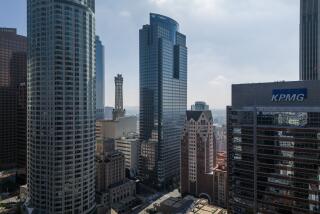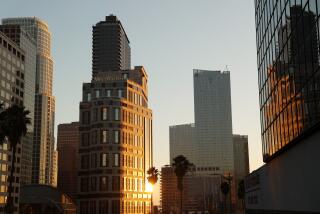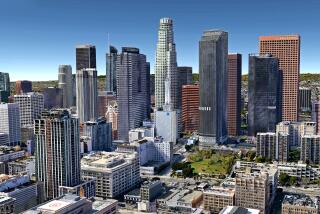Downtown L.A. landlord Brookfield is bullish on office market
- Share via
The head of the firm that wants to buy some of downtown Los Angeles’ biggest skyscrapers is bullish about its long-stagnant office market.
“We like the direction the market is heading and think it will be improving quarter over quarter.” Dennis Friedrich, chief executive of Brookfield Office Properties Inc., told industry analysts Friday. “Around the globe there has been a trend toward growth in urban centers and L.A. is looking at this over time.”
“We are being realistic about the downtown market,” he added. “It’s going to be a slow, steady improvement.”
Although downtown Los Angeles has seen a torrent of news in recent years about new hotels, restaurants, apartment complexes and entertainment venues, the office market has remained stagnant for decades, ever since the burst of new office towers went up in the 1980s and early 1990s.
On Thursday, Brookfield announced plans to pay about $430 million for four large office towers from competitor MPG Office Trust Inc. In one purchase it would become the dominant landlord on the city’s downtown skyline and end the long run of MPG, the region’s best-known but recently troubled office developer.
If the purchase is approved by shareholders of MPG as expected, Brookfield would be the largest downtown office landlord, with 8.3 million square feet to rent in seven buildings. It would face challenges to keep all that space filed with paying tenants.
Overall vacancy in the business district was 21% at the end of the first quarter, almost two percentage points higher than it was a year earlier, according to Cushman & Wakefield.
The real estate brokerage’s downtown office is in a Brookfield-owned building at Wilshire Boulevard and Figueroa Street, and the firm gets high marks locally. “They are an absolutely first-class landlord,” said John Cushman, chairman of Cushman & Wakefield. “These guys are the real deal.”
Brookfield owns $23 billion worth of office properties in some of the largest cities in the United States, Australia, Canada and the United Kingdom. Friedrich said the downtown L.A. office market will eventually catch up with others that are prospering.
Brookfield executives declined to elaborate on what they plan to do with the MPG buildings to make them more attractive to renters. Cash-strapped MPG has been hard-pressed in recent years to maintain its properties and upgrade office space to satisfy increasingly demanding tenants.
Friedrich acknowledged that some of the success Brookfield has had leasing its existing buildings was because of MPG’s financial travails and that Brookfield will lose that edge when its rival is out of the picture. “MPG has been a weak market player,” he said.
Downtown L.A. has some of the best high-rise office buildings in the country, but the newest skyscraper was completed in 1992 after one of the greatest commercial building booms in Los Angeles history ended in a bust as the economy soured.
There has been so much empty space on the market since then that developers haven’t attempted to build large new offices until only recently. Demolition of an old hotel at Wilshire Boulevard and Figueroa Street is underway to make way for a $1-billion hotel tower to be built by Korean Airlines that will also contain 30 floors of offices in its 73 stories.
The project is set to be completed in 2017 and Korean Airlines executives expect that their building’s modernity will give it an edge with renters in what they too hope will be a recovering downtown office market.
Industry observers say Korean Airlines and other landlords in the south end of the financial district stand to gain from a shifting center of gravity downtown that is pulling tenants from stately but somewhat sterile Bunker Hill to the more lively blocks above Staples Center that are attracting new restaurants, stores and apartments.
“It used to be that ground zero was Bunker Hill,” said Hans Mumper, head of the Los Angeles region for real estate brokerage Colliers International. “Now there is downsizing on Bunker Hill and people are coming down to the flats where amenities are a lot more abundant.”
Bunker Hill’s aging Victorian homes and hotels were scraped away during urban renewal projects of the 1950s and 1960s, and the area re-emerged as a premier hub of office buildings meant to serve what brokers call “corporate America.”
Law firms, accountants and financial firms settled there and still occupy much of its office space. Many of those firms, however, have reduced their office size after cutting staff during the economic downturn or by putting more workers into less space.
Brookfield already owns Bank of America Plaza on Bunker Hill and would acquire three more buildings there in the takeover of MPG: Gas Company Tower, KPMG Tower and Wells Fargo Tower. It would also get 777 Tower, which is in the south end of the financial district next to Brookfield’s Fig at 7th shopping center.
Other Los Angeles office markets have improved in recent years and downtown will too, Brookfield’s Friedrich said in the conference call. “West L.A. and markets outside downtown are tightening up,” he said. “We had in-migration into downtown of 1 million square feet in the last five years. We view viability for more demand there.”
Friedrich’s comments came after Brookfield reported its first-quarter earnings. The company showed a profit of $275 million, or 48 cents a share, down from $352 million, or 62 cents, a year earlier. Revenue was down about 1% to $628 million. Shares closed up 14 cents at $18.08 on Friday.
Brookfield’s bid to buy MPG’s shares was $3.15 a share. MPG’s stock fell a penny Friday to $3.12.
More to Read
Inside the business of entertainment
The Wide Shot brings you news, analysis and insights on everything from streaming wars to production — and what it all means for the future.
You may occasionally receive promotional content from the Los Angeles Times.











